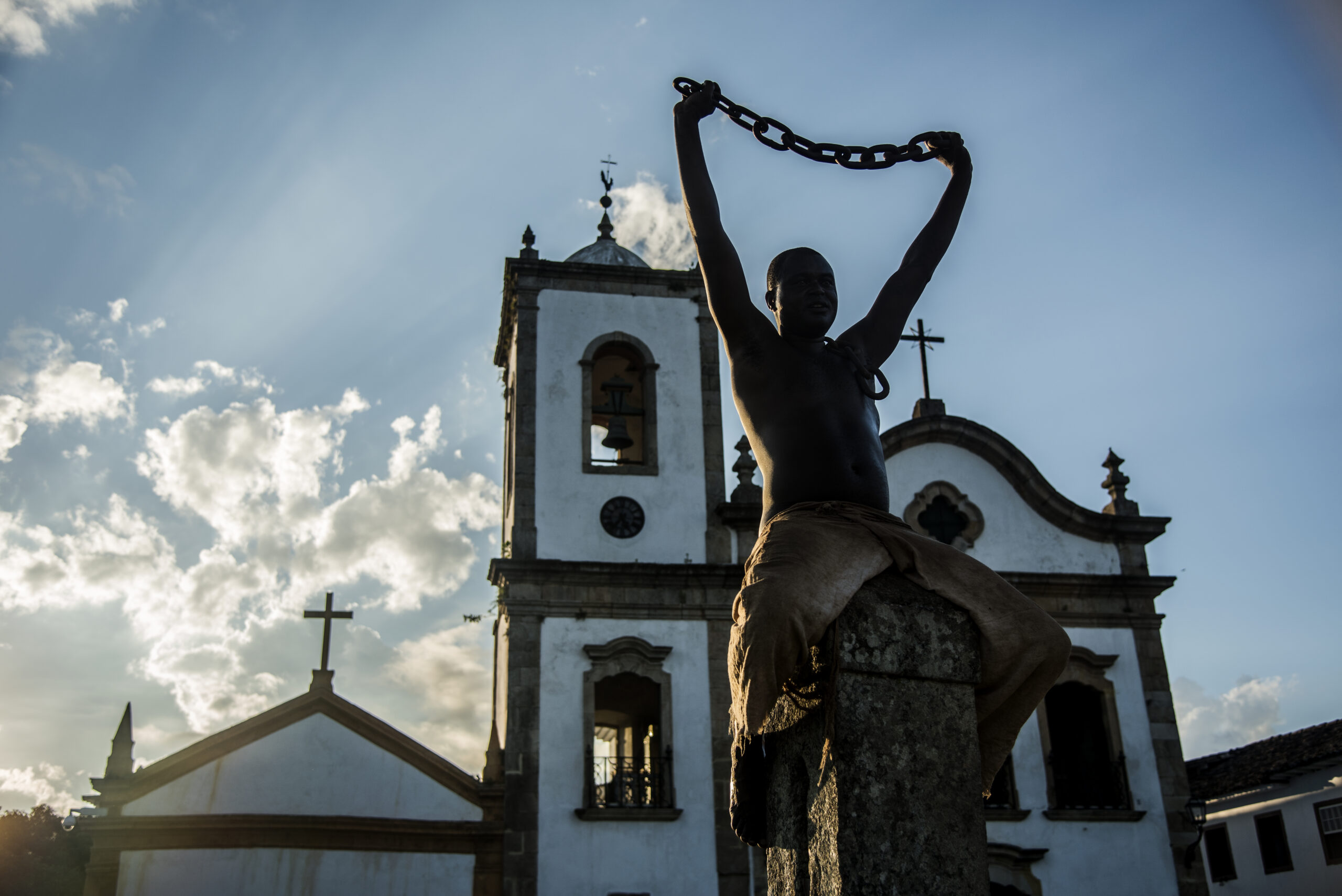Share Twitter Facebook Email Copy URL
Slavery, as a labour relationship legally admitted by the State, was abolished in Brazil in 1888. However, there are still several records of practices that subjugate human beings to conditions similar (if not worse) to those experienced by slaves. These extreme forms of labour exploitation, often associated with the idea of slave labour, are a theme that has gained prominence in recent decades.

In Brazil, since the 1990s, there have been frequent reports in the media of workers found by the State in conditions of extreme exploitation, which include accommodation shared with animals and their excrement, insufficient food, workloads incompatible with the survival of the human body, among other shocking situations. Initially, these facts seemed to be confined to distant, remote places in the country, particularly in rural areas and in the North Region. Over time, these episodes began to occur in large cities and in many different sectors of the economy.[1]
The terminology slave invariably comes up in connection with these blatant cases. It is the thread that on the one hand helps to draw attention to the extreme forms of labour exploitation, but on the other hand is also used by those who profit from this predatory management pattern. They try to play down the situations that occurred, as employers systematically claim that workers were not forced to work. The nomenclature used to define these forms of exploitation is at the heart of discussions on this issue, as it has implications for struggles to improve the working and living conditions of the victims of these practices. In the course of this, various terms such as slave labour, forced labour or contemporary slavery emerge in the literature and in institutional regulation. In Brazil, the Penal Code defines ”labour” in a way analogous to slavery, while the International Labour Organisation (ILO) normally speaks of contemporary slavery.[2]
In addition to the nomenclatures, definitions also vary about situations in which extreme forms of exploitation are associated with slavery. There are countries whose legislation uses a more restricted term and others that use a broader term that conditions the possibilities of punishing the persons involved. The main difference is whether or not the individual coercion of the employee by the employer must be described to characterise the offence.[3]
In Brazil, since 2003, the submission of a person to a condition similar to slavery has been enshrined as a crime in the Criminal Code. Literally, the law defines that this crime is carried out in practices of individual coercion (threats, violence) as well as in the extreme exploitation of labour without the need to restrict freedom, namely: subjecting workers to degrading conditions or exhaustive working hours.[4]
Over the past two decades, corporations have struggled to change the definition of labour analogous to slavery in Brazil, seeking to define that the crime only applies to direct individual coercion against freedom of movement (force or threat). However, freedom, understood from the perspective of restrictions on the right to come and go, is not the central factor that explains the extreme forms of labour exploitation in contemporary capitalism. The nature of coercion in contemporary society is effectively different from slavery and generally does not involve individual and direct forms of coercion (whether physical or symbolic) on workers. The former head of the Inspection Division for the Eradication of Slave Labor of the Ministry of Labor, Alexandre Lyra, states: “Emptying the degrading condition and exhausting work from the concept of slave-like work, there will be little left”. Profit-oriented production and the need to sell labour power in order to survive make the labour market the basic mechanism of human coercion under capitalism. Based on this structural mechanism, various cyclical, geographical, sectoral, etc. factors contribute to the spread of slave-like conditions. In general, however, they are linked to attempts to remove the remaining obstacles to the exploitation of labour by capital, such as the so-called reforms (labour, social security, etc.) that undermine workers’ rights.[5]
Although Brazil is internationally recognised as an example of the fight against slave-like labour, it lives with the perpetuation of this crime. Since 1995, more than 55,000 workers have been freed from slavery-like conditions by the Brazilian state, with no sign that this type of criminal labour exploitation has decreased in the country as a result.[6] On the contrary, many workers are repeated victims of extreme exploitation. Data from the Digital Observatory on Slave Labour in Brazil shows that 613 workers rescued between 2003 and 2017 were victims of slave-like labour at least twice.[7] This figure refers only to those who received unemployment insurance after being rescued. Research by the ILO, which surveyed rescued persons between October 2006 and July 2007, found that 59.7 per cent of workers had previously experienced such a situation.[8]
The fight against slave-like labour in Brazil is hampered both by limited repressive measures, from inspections to the handling of cases in court, and by the fragility of policies to support rescued workers and the most vulnerable sectors of society.
Reducing extreme forms of labour exploitation in Brazil is a challenge with centuries-old roots.[9] Actors and institutions mobilising against extreme exploitation must overcome the idea that the subjugation of workers is fundamentally linked to direct individual coercion (physical violence, threats, etc.) or the restriction of freedom. Otherwise, there will always be room for those who use and defend the right to exploit to deviate from the essential element that subjects workers to these conditions: the coercion of the labour market based on the elimination of the “right to life” imposed by capitalism.
Vitor Filgueiras is Professor of Economics at the Federal University of Bahia, Brazil. He is involved in the project “Vida Pós Resgate” (Life After Rescue) that was created in 2017 through a partnership between the Federal University of Bahia’s Faculty of Economics and the Federal Labor Prosecution Office for the 23rd Region, with the goal of investigating the fate of workers who have exited slave-like conditions in Brazil, particularly in the states of Mato Grosso and Bahia. He is also part of the project “Caminhos do Trabalho”, a partnership between the Labor Public Ministry and the Federal University of Bahia in defense of workers' rights. Vitor contributes to the website Delta 8.7.
[1] Filgueiras, Vitor Araújo.Trabalho Análogo ao Escravo e o Limite da Relação de Emprego: Natureza e Disputa na Regulação do Estado.Brasiliana –Journal for Brazilian Studies. Vol. 2, n.2 (Nov 2013)
[2] Filgueiras, Vitor Araújo.Trabalho Análogo ao Escravo e o Limite da Relação de Emprego: Natureza e Disputa na Regulação do Estado.Brasiliana –Journal for Brazilian Studies. Vol. 2, n.2 (Nov 2013)
[3] Filgueiras, Vitor Araújo.Trabalho Análogo ao Escravo e o Limite da Relação de Emprego: Natureza e Disputa na Regulação do Estado.Brasiliana –Journal for Brazilian Studies. Vol. 2, n.2 (Nov 2013) and SAKAMOTO, Leonardo (org.) Escravidão contemporânea. São Paulo : Contexto, 2020.
[4] Filgueiras, Vitor Araújo.Trabalho Análogo ao Escravo e o Limite da Relação de Emprego: Natureza e Disputa na Regulação do Estado.Brasiliana –Journal for Brazilian Studies. Vol. 2, n.2 (Nov 2013), SAKAMOTO, Leonardo (org.) Escravidão contemporânea. São Paulo : Contexto, 2020.
[5] Figueiras, Vitor. LABOR MARKET AND COERCIONON WORKERS: Brazil, United Kingdom and the advance of the “satanic mill”. Revista da ABET, v. 15, n. 2, Julho a Dezembro de 2016
[6] https://sit.trabalho.gov.br/radar/
[7] https://sit.trabalho.gov.br/radar/
[8] https://politica.estadao.com.br/noticias/eleicoes,reincidencia-no-trabalho-escravo-chegou-a-59-imp-,790577
[9] Cerqueira, Gelba; Figueira, Ricardo; Prado, Adonia; Costa, Célia Maria (Orgs.).Trabalho escravo contemporâneo no Brasil: contribuições para sua análise e denúncia.Rio de Janeiro, Editora UFRJ, 2008



